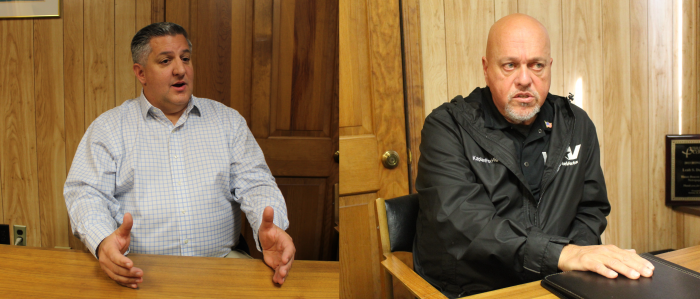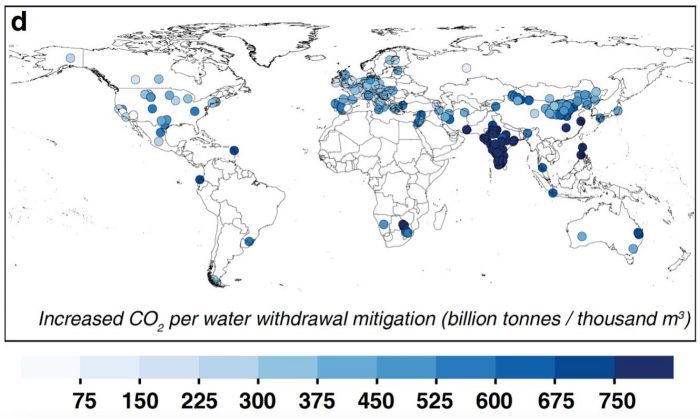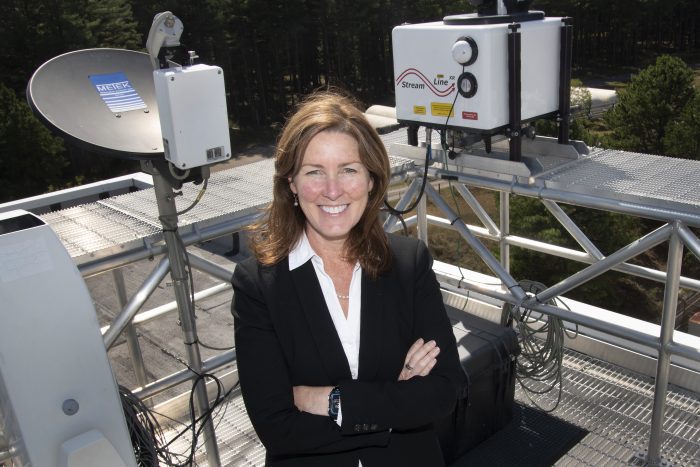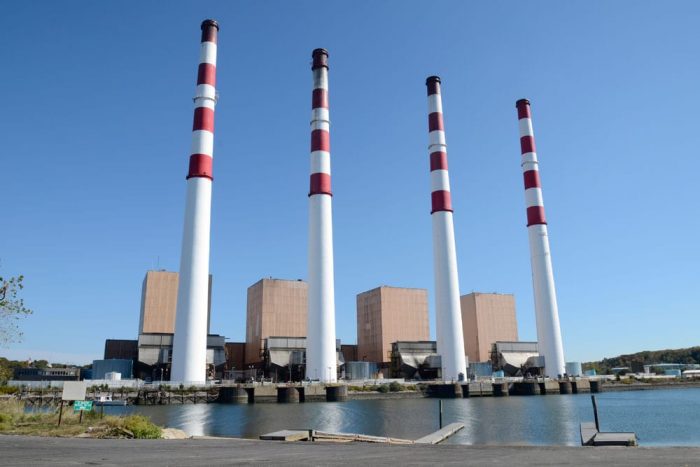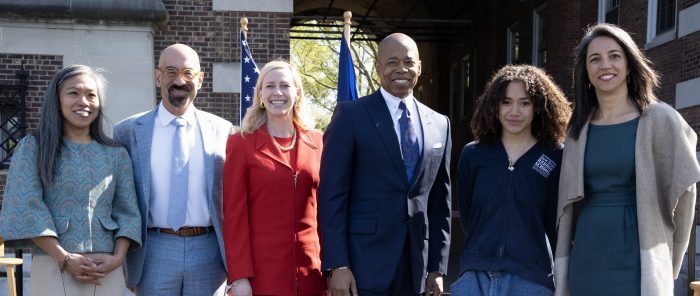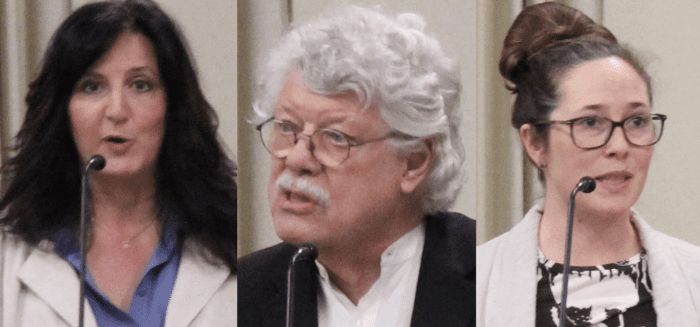By Aidan Johnson
As Election Day nears, residents will decide between two candidates for Town of Brookhaven highway superintendent.
Current highway superintendent, Dan Losquadro (R), and Michael Kaplan (D) took part in an exclusive debate at the TBR office Friday, Oct. 27, tackling issues such as response times, paving schedules and the impact of storms on roads.
Introductions
Losquadro has served as highway superintendent for almost 11 years but has held public office for roughly two decades.
He started out after winning a special election in 2003 for Suffolk County’s 6th Legislative District. After serving two years in the Legislature, his colleagues elected him to be the Republican Conference Leader at age 33. He gave the rebuttals to Suffolk County Executive Steve Levy’s (D) State of the County address at that time.
He moved on to serve in the New York State Assembly but preferred staying home with his family. After people started lobbying him to replace former Highway Superintendent John Rouse (D), Losquadro decided to do so, citing his past work in his father’s body shop and as a laborer with Local 66 as what trained him for the job.
Kaplan has had 30 years of experience in municipal highway departments, serving 20 years in Islip and 10 years in Huntington. During that time, he served as a laborer, road inspector and worked directly for the superintendent of highways in Huntington. Additionally, he has served as a union leader and is a U.S. Army veteran.
While Kaplan indicated he did not want to speak negatively about Losquadro, he said that he has differing opinions on how to run the department and that there have been “a lot of residents” who have told him that they wish to see the superintendent more often.
Functions of the office
Losquadro said that the “umbrella of the Highway Department is much larger than people realize.” It is not just about the care of the roads but includes areas such as the traffic safety division for the town, engineering where all highway work permits go through, stormwater management and street lighting.
Losquadro runs a budget of more than $110 million, has nearly 300 employees, oversees 3,500 lane miles of roads and believes in innovation for moving the department forward, citing his digitizing of the work order system along with the conversion of all of Brookhaven’s street lights to LEDs, with Brookhaven’s energy savings being up to $1.2 million a year.
He has also brought in over $150 million from the state and federal grant funding to the town, including a $16 million grant to replace the Sheep Pasture Road bridge in Port Jefferson Station earlier this year.
Kaplan stated that Losquadro touched on a lot of the functions. However, he said that after knocking on thousands of doors, he has a different perspective on how the Highway Department should be run daily.
Kaplan said that the workforce needs to be built back up, both in the sense that it is not enough and because it is demoralized. While he noted Losquadro has done a good job, Kaplan also stated that there are many residents who are frustrated with a perceived lack of accessibility and poor response time within the department, along with people not receiving an answer to their concerns.
As the head of the department, Kaplan said he would be talking to the employees and residents “every single day” and explain to them the answer to their problems, “whether they like my answer or not.” Kaplan also believes that he has to have a staff with the same vision of public service and that while the employees come first, “it’s really all about the residents.”
Losquadro rebutted this, saying he is “as hands-on as it gets” for a highway superintendent and that he and his staff deal with residents “day in, day out.” However, he said that one of the problems is that some people will call other local officials if they do not like the answer the Highway Department gives them, and claim that they did not get a response. However, the electronic work order system can show that the department has been in touch. While they sometimes miss the mark, he indicated, they still strive to contact every person promptly.
Climate change
With climate change increasing the threat of environmental disasters, including major snowfall events, Kaplan believes that it is imperative to build up private contractors.
Kaplan also said that road sweeping is a vital part of conserving the environment because if the road is not swept, everything washes down into the catch and recharge basins, polluting the aquifers.
While there hasn’t been a big snowstorm in recent years, Kaplan said one big snowfall is enough to remind everyone that what the department does is vital. He also said that there is a science to snow plowing that he would teach every individual what to do behind the wheel of a truck.
Kaplan also said that, with a larger workforce, he would want to have a snow plowing operation that encompasses all of the roads, both main and side, at the same time.
Losquadro noted that climate change has also caused issues such as roads that were once dry at high tide to now be underwater at normal tide. Because of this, Highways has worked with the Law Department and has abandoned a number of roads.
Due to rising sea levels, Losquadro has been “seeking grants anywhere I can get them.” Currently, the department is raising the roads along Mount Sinai Harbor and doing a massive drainage project there so that the roads remain passable at high tide when water gets impounded in the harbor along the southern shore.
Since there is no capacity for drainage along the southern shore, the department has been acquiring parcels and using them as bioretention areas to make the roads passable.
Losquadro has also increased the rate paid to snow plow vendors by 25% this year. However, the department is facing a problem that the younger generation of contractors is not getting into the snow plowing business, so is trying to incentivize outside contractors.
Response times
Losquadro elaborated on the electric work order system he put in place, describing how a variant is used during severe weather events, containing “a simple dropdown menu” with which they can put information into quickly.
Additionally, a foreman can use iPads during a work order to take pictures and type in their notes to transmit the information instantly to a customer service representative, who can then relay it back to the resident in cases such as evaluations and inspections.
The department has also added the ability to track all of the road signs in its geographical information system and have added almost 200,000 drains. Losquadro said they “continue to add functionality to the system and build on it” to be more efficient.
While Kaplan said that he respects what Losquadro had to say, if elected, he would go back to the “old school way of doing things” by being a “boots on the ground” superintendent immediately.
If someone calls with a concern, including issues of potholes, Kaplan said he would institute a 72-hour correspondence policy, meaning that the person calling would receive correspondence, such as a callback or email, explaining that their issue has been recognized, and then a time to have it repaired will be scheduled.
Additionally, Kaplan said that potholes would be filled and repaired within 48 hours, and he would reteach his employees how to fill a pothole by his standards.
Politicization claim
In response to claims that Losquadro only begins to fix roads and potholes right before an election, Losquadro considered this notion “absurd.” He further said that the paving season runs from April to November, with someone being first and someone being last during the paving season.
According to the incumbent, they schedule the work based on how much concrete or drainage work has to be performed on a given project, with the jobs that require less work being done in the spring since they can get the prep work done sooner. Anything involving schools is done over the summer so as not to disrupt access to the schools, and the projects done in the fall require more extensive concrete or drainage work.
Losquadro also said that they spend nearly the same amount of money each year, exclusive of grant funding for individual projects, and do not spend more during an election year.
While Kaplan did state that he did make a comment about allegations that Losquadro only begins to fix potholes and roads around election time, he did not mean that as a disrespectful comment toward Losquadro. He had made the comment because residents have told him that they would repeatedly ask for an issue to be addressed, and it would only happen “three months before an election.”
Paving schedules
Kaplan said that he would have a delegation involved in assessing all of the roads in Brookhaven since the highway superintendent could not feasibly do it by themself. He would have the roads rated A through F, with the roads receiving “D” and “F” ratings being placed on the high-priority list.
Losquadro said that prioritizing a roadway isn’t just “necessarily a visual assessment” since there may be cases where the top layer of a road may appear to be in disrepair while the subsurface is still very strong, and vice versa.
If reelected, Losquadro pledged to avail himself of a program offered by the Cornell Cooperative Extension that uses optical sensors to evaluate the condition of the town’s roads to get what he referred to as a “heat map.”
Losquadro added that he feels that they have gotten through the roads that were in very poor shape that he inherited from the last highway superintendent. He is planning two-to-three years out in the paving schedule, which is why the overall optical evaluation of the roadways would be helpful in how he looks forward at a possible three-to-eight years out from this point.
Brookhaven residents townwide will decide on the Highway Department’s future on Tuesday, Nov. 7.

